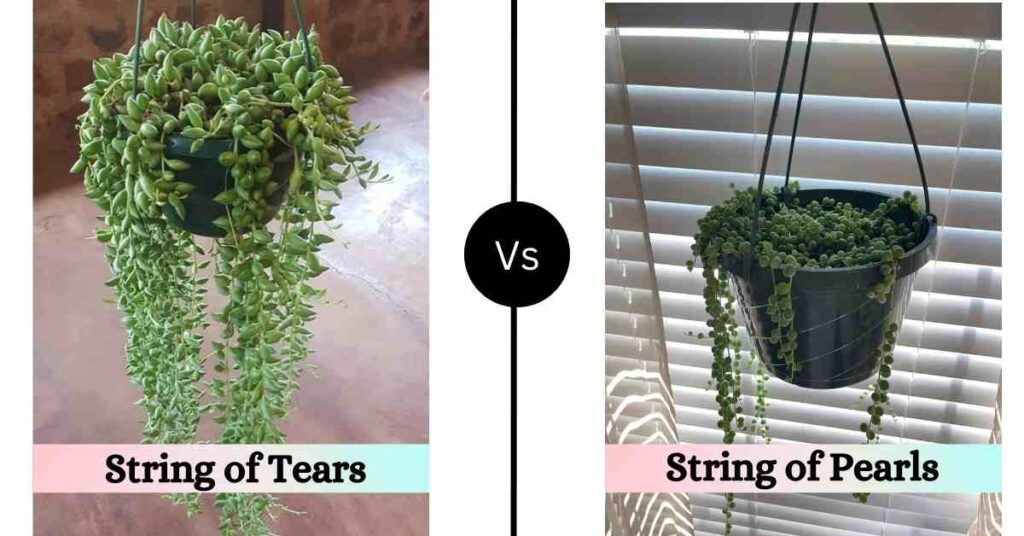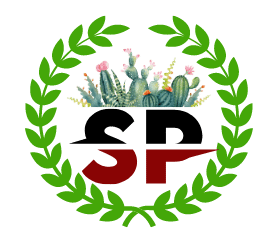Have you ever thought of decorating your Balcony with strings covered with beautiful leaves?? If yes, then a string of tears is a pretty good option. You can grow this plant in a hanging basket on your Balcony with minimal care. The only thing to care for is that they must be provided with support to cling onto, like string or wire.
Introduction
The string of tears is a wonderful succulent plant that is low maintenance, has an attractive aesthetic form and its silvery green color compliments a variety of settings. Senecio is a trailing succulent that belongs to the Asteraceae family with beautiful white flowers. It is named a string of tears because the leaves resemble the shape of a tear. Pretty similar to other succulent plants, watering isn’t much needed. The best time to water this plant is when the upper soil gets dry.
Roots
Roots are very small and soft which they cannot penetrate in hard soil. Therefore, porous soil with a sufficient amount of organic matter is required for the propagation of Senecio. If there is well pulverized porous soil the roots can grow from anywhere.
Leaves and stems
The leaves and stems are green in color and are succulent. The stems grow to about one foot in length and consist of many teardrop-shaped leaves. We can use both stems and leaves for propagation.
Flower
A string of tears produces white trumpet-shaped flowers which have a cinnamon or clove-like scent. The flowers are small and white with a yellow center and flowering takes place during spring and summer season.
Special Features
1. Glossy green tear-shaped foliage with white flowers.
2. Can be grown in pots, hanging baskets, and as ground cover.
3. Survive at an average temperature with less water.
4. Easy to propagate
5. Low maintenance of perennial succulent plants.
5. Less susceptible to diseases.
A Quick Overview Of This Succulent Is Tabulated Below:-
| Plant Name | Senecio citriformisis |
| Other Name | String of water drop, String of lemons |
| Grown for | Foliage |
| Plant type | Trailing perennial Succulent |
| Family | Asteraceae |
| Origin | South Africa and Namibia |
| Nature of plant | Evergreen |
| Life span | 3 to 5 years |
| USDA growing zone | USDA 9b to 11b |
| Flower colour | Creamy yellow flowers |
| Blooming time | Spring and summer |
| Height | 1″ |
| Width | 0.3″ |
| Exposure | Bright indirect light or partial shade(Eastern and southern exposure is preferred), Grow under a tree or bush when growing outdoors, 6 hrs indirect sunlight |
| Cold tolerance | Susceptible to frost. |
| Irrigation | When soil gets dry |
Botanical Classification
| Kingdom | Plantae |
| Clade | Tracheophytes |
| Clade | Angiosperms |
| Clade | Eudicots |
| Order | Asterales |
| Family | Asteraceae |
| Scientific name | Senecio |
USDA Growing Zone
Like an Agave, a String of tears can be grown in the USDA hardiness Zone 9 -11. These areas include the most tropical climate in the US like Florida, Southern Louisiana, Texas, and California. These areas of the US are warm in summer and mild in the winter.
Is It Toxic?
The sap of a string of tears is toxic to both humans and pets. Since a cousin of String of Tears, Senecio rowleyanus is mildly toxic to humans and can cause symptoms such as diarrhea and vomiting, we can assume that this plant can also cause similar symptoms. So, it is wise to keep this succulent out of reach of children and pets. It is always better to wear gloves while working with a string of tears.
String of Tears vs String of Raindrops
There is no difference between string of tears and string of raindrops. They both are the same.
String of Tears vs String of Pearls

| String of Tears | String of Pearls |
| Teardrop shaped leaf | Pea shaped leaf or like a small ball of pearls. |
| Requires neutral loamy soil | Requires neutral to acidic sandy loam soil. |
| Smaller than a string of pearls, Stem can reach a height 1 foot. | Larger than Stem of tears, Stem can reach a height 3 feet. |
String of Tears vs String of Watermelon

A string of tears has teardrop-shaped leaves but the leaves of the string of watermelons are pretty similar to miniature watermelons with purple lines.
String of Tears vs String of Bananas

As mentioned above, the string of tears resembles a teardrop, they are somewhat pointed to the end. While a string of bananas is also a succulent plant but with a banana-shaped leaf.
Variegated String of Tears

A variegated string of tears consists of more than one color which makes it stunning. They have a blend of two colors light green and green.
String Of Tears Care
| Light | Partial shade or indirect bright sunlight |
| Soil | Well draining Sandy or loamy soil rich in organic matter.-pH 6.0 to 6.5( slightly acidic) |
| Humidity | Average humidity i.e 50 percent |
| Water | Once or every two weeks |
| Temperature | 64 degree F to 75 degree F |
| Fertiliser | A cactus/succulent soil mixOnce a year.Preferable time -Summer |
| Repotting | Every two or three years |
| Pruning | Requires every now and then for proper air circulation. |
Soil
Well-drained, sandy, or loamy soil rich in organic matter with a pH range of 6 to 6.5 is ideal for the growth of this plant. On the other hand high levels of clay create an obstacle for the root to flourish. Thus, clay soil cannot be used. Additionally, this plant is prone to root rot in heavy, poorly drained soils.
Sunlight and Temperature
For the string of tears to flourish, there must be sufficient light. It is better to place the plant near a window or artificial light sources such as fluorescent lamps or incandescent bulbs which will assist in maintaining a warmer interior temperature creating a favorable environment for the growth of the plant.
Aspect -It is suitable to place them in an east or south-facing window and make sure this plant receives at least six hours of indirect light each day. When grown outdoors they should be grown under a tree or bush because they love indirect bright sunlight.
the plant needs a temperature range between 64 and 75 degrees F. As this plant is very susceptible to frost, extra care should be given to protect it from cold temperatures.
Water and Humidity
Since it requires moist soil we should water it frequently. But, we must be conscious that we are not watering too much cause this plant cannot withstand water lodging conditions. So, water the plant only when the soil gets dry.
The leaves should be misted or humidified, especially if they are situated in places with low air humidity and a dry climate.
Fertilizer
Fertilizer should be given in the growing season rather than in the dormant season. During the growing seasons (spring through fall), fertilize the string of tears plant once every two weeks with a water-soluble fertilizer mixed as directed on the label. A weak solution of balanced, water-soluble fertilizer diluted to half strength is appropriate for its growth. We must avoid over-fertilizing which makes the String of tears soft and ultimately make them lose their distinct shape.
Potting and Repotting
This beautiful succulent requires a deep pot having a sufficient width with a hole in it for better drainage. Repotting should be done every two to three years. When the roots start to come out through the bottom of the current one it is time for repotting. The favorable time for transplanting is during the fall or winter months.
Pruning
Trimming is frequently necessary for this plant to increase air circulation around the foliage, which lowers humidity buildup around the middle leaf layer of the plant. A strong plant that is not properly trimmed will quickly outgrow its container making it look bad.
Further, when we limit the vegetative growth by pruning we can enhance the reproductive growth and can obtain more flowers. Thus pruning has a significant effect on the management of a string of tears.
The best time to trim them is in September and October, just before the plant begins to sprout new growth for the upcoming year. We must keep in mind that we cannot prune this plant during its dormant period i.e. in December.
Propagation
Since the string of tears cannot tolerate freezing temperatures, we should not propagate in the winter. Other seasons are favourable cause we can fulfil the water requirements manually without depending upon the rain. However, the Summer and spring seasons are the best for its propagation.
It can be easily propagated through following methods:-
1. Division
Propagation of the string of tears from the division method is just a piece of cake. We can just simply separate the plant by digging and using the part for growing new plants. However, the dug part should be planted immediately. We must not take division when the plant is blooming. It provides stress and the flowering rate slows.
Process
1. Take a pot with a hole in it and fill it with loamy soil along with organic matter.
2. Then gently put plant parts in the pot and cover them with soil or organic mulch like peat moss, straw, or hay.
3. Water the plant and keep it in indirect sunlight.
2. Cutting
Cut the part of the stem except in blooming time and make it dry for about two weeks to kill the sap. We can cut the stem of any length, however, it would be better to cut according to the pot size. Dip the cut portion in the rooting media for proper root development and grow in loamy soil as in the division process. Instead of root cutting, we can also take leaf cutting, but at least two leaves should be taken.
Price
| Size | Price |
| 2 inch | $11.75 |
| 4 inch | $20.65 |
| 6 inch | $44.05 |
Common Problems
Pest
The chances of the occurrence of pests are not very common. However, some pests like white flies, spider mites, aphids, mealybugs, and scale insects can attack the string of tears if not taken care of.
Disease and Disorder
When the plant is under stress and not thriving well, several pathogens attack it and cause powdery mildew, rust, wilt, blight, etc.
Among these diseases, botrytis blight is considered a very serious disease. To avoid this disease proper growing conditions should be provided. If more leaves start showing symptoms of blight we should spray recommended dose of fungicide.
Disorder
A string of Tears Shriveling
The reason behind Shriveling of String of Tears is insufficient water supply. Due to water scarcity, water storage runs down in their leaves making them shrivel. To prevent this we must water it whenever the soil gets dry.
Moreover, conditions like over watering, under watering, soil type, intense sunlight, lack of sunlight, etc can create lots of disorder in this plant.
Pros and Cons
| Pros | Cons |
| Easy to grow and propagate | Regular pruning required |
| Benefit of both beautiful foliage and attractive flowers. | Prone to root rot if over watered |
| Evergreen perennial succulent plant | Sap contains toxic material. |
| Low maintenance | Water scarcity leads to shrivelling of leaves. |
Final Verdict
A string of tears is a perennial evergreen succulent plant that is easy to maintain and produces alluring flowers. It can be grown both indoors and outdoors. We can grow the string of tears in a pot, in a hanging basket on the balcony, and as a ground cover. But most importantly it is grown in a hanging basket. So if you plan to add the plant to your Balcony but don’t have much space, you can just hang them and make your surrounding green and calm, of course.
FAQs
1. Is a String of Tears the same as a string of pearls?
No, they are not the same. There is a difference in shape; a String of tears, as the name suggests has elongated tear-shaped leaves whereas a string of pearls has pea-shaped leaves. Further, strings of tears usually grow 3 feet long while strings of pearls grow on vines up to three feet long.
2. Why is my string of tears losing leaves?
When we keep the string of tears in places with cold or mild temperatures the leaves start to fall. So make sure you are providing average temperature to this plant.
3. Is the string of tears an indoor plant?
String tears can be grown in both indoor and outdoor conditions. But when growing indoors we must provide them with sufficient indirect bright light (around 6 hrs).To a greater extent, it should provide sufficient water for the leaves to thrive.
4. Can you propagate a string of tears from one leaf?
Yeah, we can propagate a string of tears from one leaf but it can be more challenging than propagating from stem cutting or offsets. To increase the chances of propagation we should select porous soil and make soil moist all the time.
5. Why is my string of tears drying up?
If we water unnecessarily the plant gets dry. In the soil which retrieves moisture fast, we should irrigate only when the soil is completely dry to prevent a string of tears from drying up.


